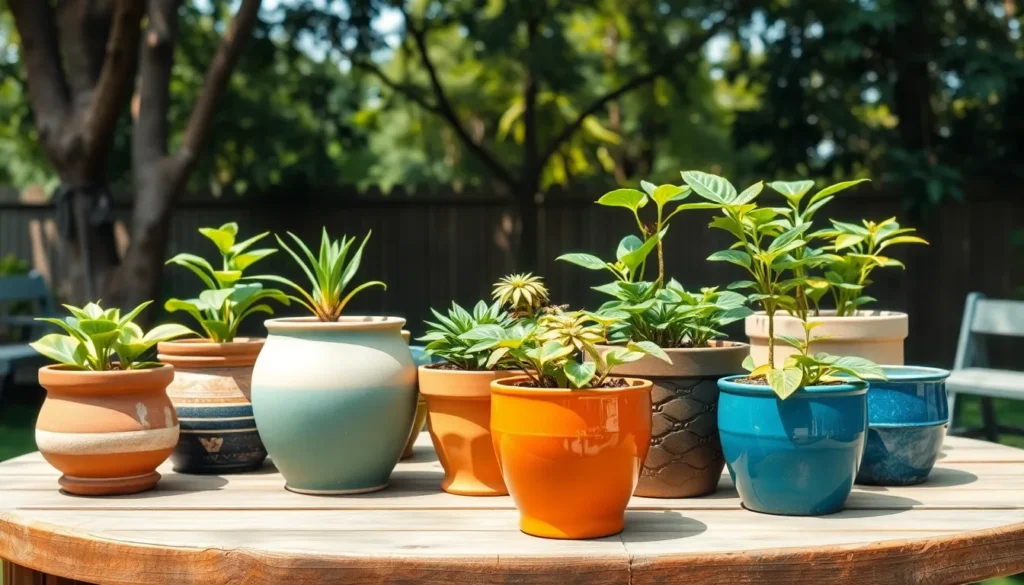We’ve all watched our houseplants struggle in plastic containers – poor drainage, root rot, and stunted growth become frustrating realities. Clay pots for plants offer a time-tested solution that transforms your gardening experience and gives your green friends the environment they desperately need to thrive.
Clay’s natural porosity creates the perfect balance of moisture retention and airflow that plastic simply can’t match. Your plants’ roots breathe easier while excess water evaporates through the clay walls, preventing the waterlogged conditions that kill more houseplants than drought ever could.
Whether you’re nurturing delicate succulents or robust flowering plants, clay pots deliver results that’ll make your neighbors wonder about your secret gardening skills. We’ll explore why these ancient containers remain the gold standard for serious plant parents and how choosing the right clay pot can mean the difference between barely surviving plants and a thriving indoor jungle that becomes the envy of every visitor.
Choose the Right Size Clay Pot for Your Plant’s Growth Stage
Selecting the proper clay pot size directly impacts your plant’s health and growth potential. We’ll guide you through the essential sizing considerations that complement the superior drainage benefits clay pots already provide.
Match Pot Diameter to Plant Root System
Start with a pot that’s 1-2 inches wider than your plant’s current root ball. Most houseplants like pothos, snake plants, and rubber trees thrive when their roots have just enough space to spread without swimming in excess soil. We recommend measuring your plant’s root system during repotting and choosing a clay pot diameter that allows for modest expansion.
Avoid oversized containers that dwarf your plant’s root structure. Large clay pots hold more moisture than smaller root systems can absorb, potentially creating soggy conditions even though clay’s natural porosity. Succulents and cacti particularly suffer in oversized containers where their shallow root systems can’t use the available soil volume.
Consider the mature spread of your plant species when selecting diameter. Fiddle leaf figs eventually develop extensive root networks requiring 12-16 inch clay pots, while herbs like basil and oregano remain content in 6-8 inch containers throughout their growing season.
Consider Depth Requirements for Different Plant Types
Deep-rooted plants need clay pots with substantial vertical space for optimal development. Tomatoes, peppers, and fruit trees require containers at least 12-18 inches deep to accommodate their taproot systems. We’ve found that shallow clay pots restrict these plants’ growth and reduce their productive capacity.
Shallow-rooted species perform better in wide, low-profile clay containers. Lettuce, strawberries, and most annual flowers develop fibrous root systems that spread horizontally rather than vertically. These plants flourish in clay pots that are 6-8 inches deep but offer generous surface area.
Bulb plants have exact depth requirements based on their size and type. Plant tulip and daffodil bulbs in clay pots at least three times the bulb’s height, while smaller bulbs like crocuses need pots only 4-6 inches deep.
Plan for Future Growth and Repotting Needs
Purchase clay pots in graduated sizes to accommodate your plant’s growth timeline. Most houseplants require repotting every 1-2 years, so having the next size available prevents emergency shopping trips. We suggest buying 6-inch, 8-inch, and 10-inch clay pots for plants you plan to grow long-term.
Fast-growing plants like monstera and philodendron may need larger clay pots within 6-12 months. These vigorous growers quickly outpace their containers, and having appropriately sized clay pots ready ensures smooth transitions. Young plants in 4-inch pots typically graduate to 6-inch containers, then 8-inch pots as they mature.
Slow-growing species like ZZ plants and peace lilies can remain in the same clay pot for 2-3 years. These plants prefer being slightly rootbound and don’t require frequent size increases. We recommend monitoring their drainage holes for emerging roots as the primary indicator for repotting into larger clay containers.
Select the Best Clay Pot Material for Optimal Plant Health
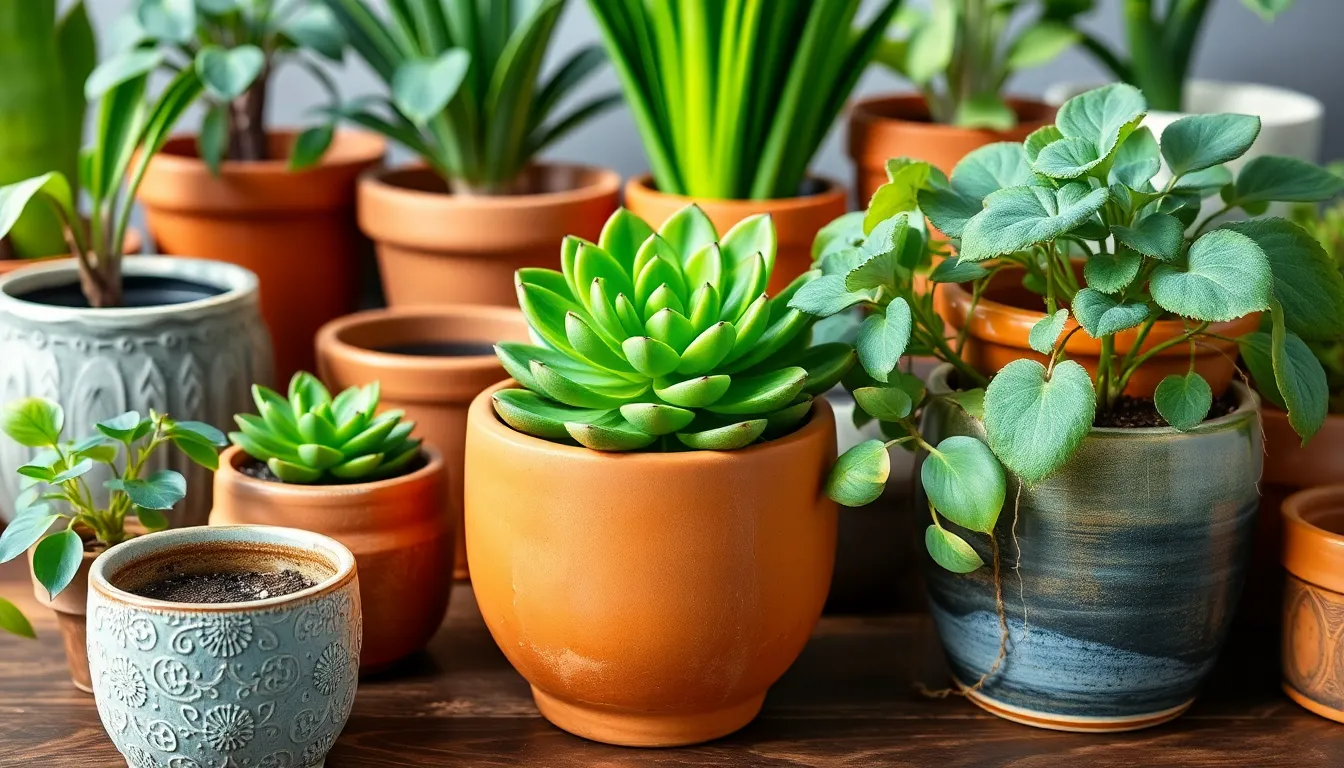
We’ll explore different clay pot materials that offer distinct advantages for your plants’ exact needs. Choosing between terracotta and glazed clay options significantly impacts your plant’s health and growth potential.
Understanding Terracotta vs. Glazed Clay Options
Terracotta pots deliver unmatched breathability through their highly porous structure. These unglazed clay containers allow excellent air and water permeability, reducing overwatering risks and preventing root rot in moisture-sensitive plants. We recommend terracotta for plants that thrive in well-draining conditions.
Glazed clay pots retain more water due to their lower porosity levels. The glazing process creates a less porous surface that maintains consistent moisture levels, making these containers ideal for plants requiring steady hydration. These pots also offer enhanced decorative appeal with their finished appearance.
Temperature regulation becomes easier with terracotta’s natural breathability. The porous material helps keep roots cooler during hot conditions while moderating temperature fluctuations that can stress sensitive root systems. Glazed options provide better moisture control in environments where rapid soil drying poses challenges.
Evaluate Porosity Levels for Different Plant Species
Succulents and cacti perform exceptionally well in highly porous terracotta containers. These plants require excellent drainage and aeration, which terracotta’s breathable structure naturally provides. We’ve found that classic unglazed clay pots prevent the waterlogged conditions that typically kill desert plants.
Plants requiring constant moisture benefit from glazed clay’s reduced porosity. Species that prefer consistently damp soil or aquatic plants fare better in these lower-porosity containers. The glazed surface minimizes water evaporation while still providing clay’s natural benefits.
Visual moisture indicators help us monitor hydration needs effectively. Unglazed clay develops darkened spots when moist, creating a self-regulating moisture monitoring system. This natural feature eliminates guesswork in watering schedules for many plant species.
Consider Weather Resistance for Outdoor Use
Freeze-thaw cycles pose important challenges for terracotta containers. The porous material absorbs water that expands when frozen, causing cracks and structural damage in regions with frequent temperature fluctuations below freezing. We recommend protecting these pots during winter months in cold climates.
Glazed clay provides superior protection against moisture penetration. The glazed surface creates a barrier that reduces water absorption, offering better resistance to freeze damage. But, both clay types may still require seasonal care or insulation in harsh winter conditions.
Winter protection strategies extend your clay pots’ lifespan significantly. Moving containers to protected areas, wrapping them in insulating materials, or selecting specifically weather-resistant clay formulations helps maintain their integrity through challenging outdoor conditions.
Ensure Proper Drainage in Your Clay Pots for Plants
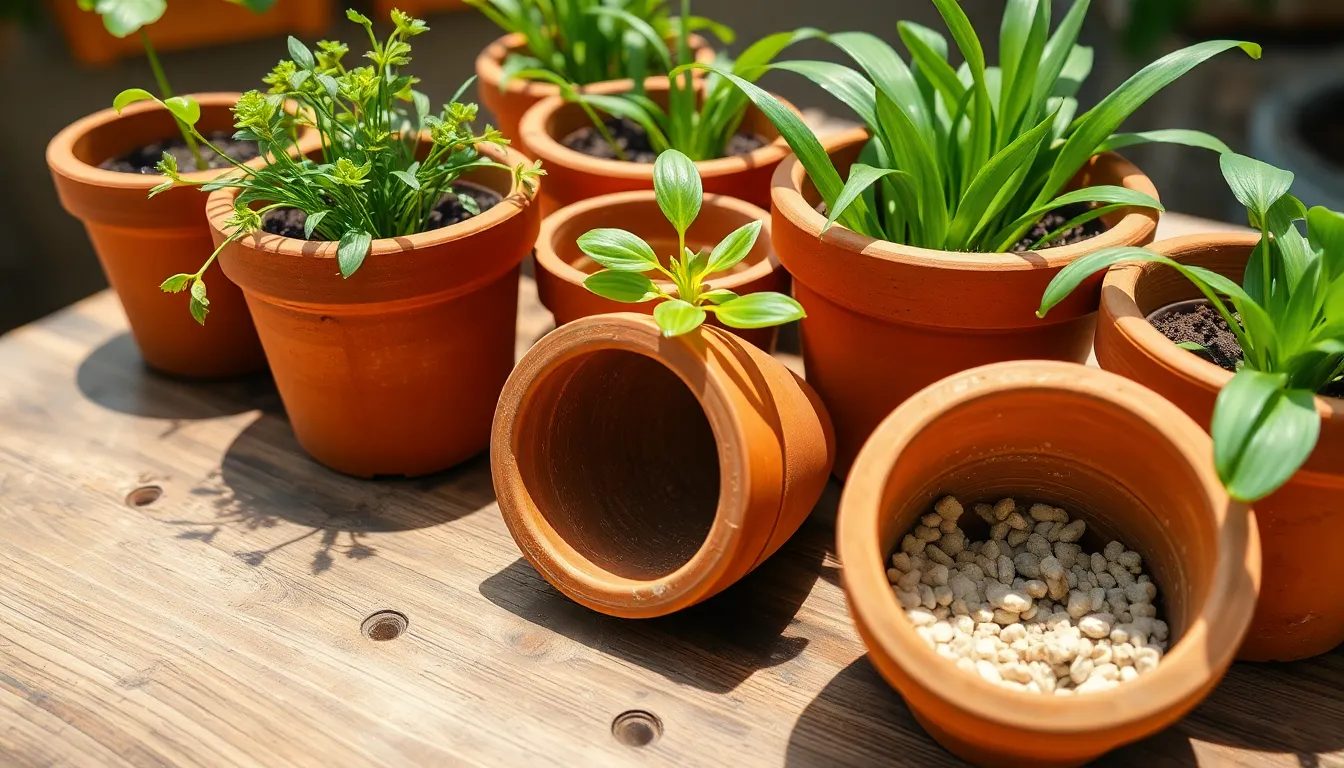
Proper drainage transforms your clay pots into thriving environments where roots can flourish without the threat of waterlogging. We’ll explore the essential techniques that prevent root rot and promote healthy plant growth.
Look for Multiple Drainage Holes in the Bottom
Check for adequate drainage holes before purchasing any clay pot for your plants. Small to medium terracotta pots typically require only one drainage hole due to their natural porosity, which allows moisture to evaporate through the walls. Larger clay containers and glazed terracotta pots need multiple evenly spaced drainage holes to ensure uniform soil drying and efficient water escape.
Create additional drainage holes if your clay pot lacks sufficient openings. We recommend drilling carefully to avoid cracking the clay material. Position the holes evenly across the bottom surface to promote balanced water distribution and prevent soggy spots that could damage your plant’s root system.
Space drainage holes properly to maximize water flow efficiency. Multiple holes work together to create optimal drainage conditions, particularly important for larger containers where water tends to accumulate in exact areas.
Add Drainage Layer Materials for Better Water Flow
Place drainage materials at the bottom of your clay pot before adding potting soil. Suitable options include drainage stones, LECA (lightweight expanded clay aggregate), broken pottery pieces, crocks, or small rocks that create essential air pockets for water movement.
Create a drainage layer that measures approximately one quarter of your pot’s total height. This layer provides space for excess water to pool away from your plant’s roots while improving air circulation around the root zone. We’ve found this technique particularly effective for preventing waterlogged conditions that lead to root rot.
Choose appropriate drainage materials based on your pot size and plant needs. LECA offers excellent drainage while remaining lightweight, making it ideal for larger containers. Broken pottery pieces provide traditional drainage benefits while recycling old clay materials.
Position Saucers Correctly to Prevent Root Rot
Empty saucers regularly to prevent standing water from creating soggy conditions around your plant’s roots. Water that sits in saucers for extended periods can be reabsorbed by the clay pot, leading to oversaturated soil and potential root rot issues.
Elevate your clay pots slightly using pot feet or small stones to allow excess water to drain freely and air to circulate beneath the container. This technique prevents water from pooling directly under the pot while maintaining the protective benefits of using a saucer.
Monitor saucer water levels consistently to maintain optimal drainage conditions. We recommend checking saucers within 30 minutes after watering and removing any excess water that hasn’t been absorbed by the plant or evaporated naturally.
Prepare Your Clay Pots Before First Use
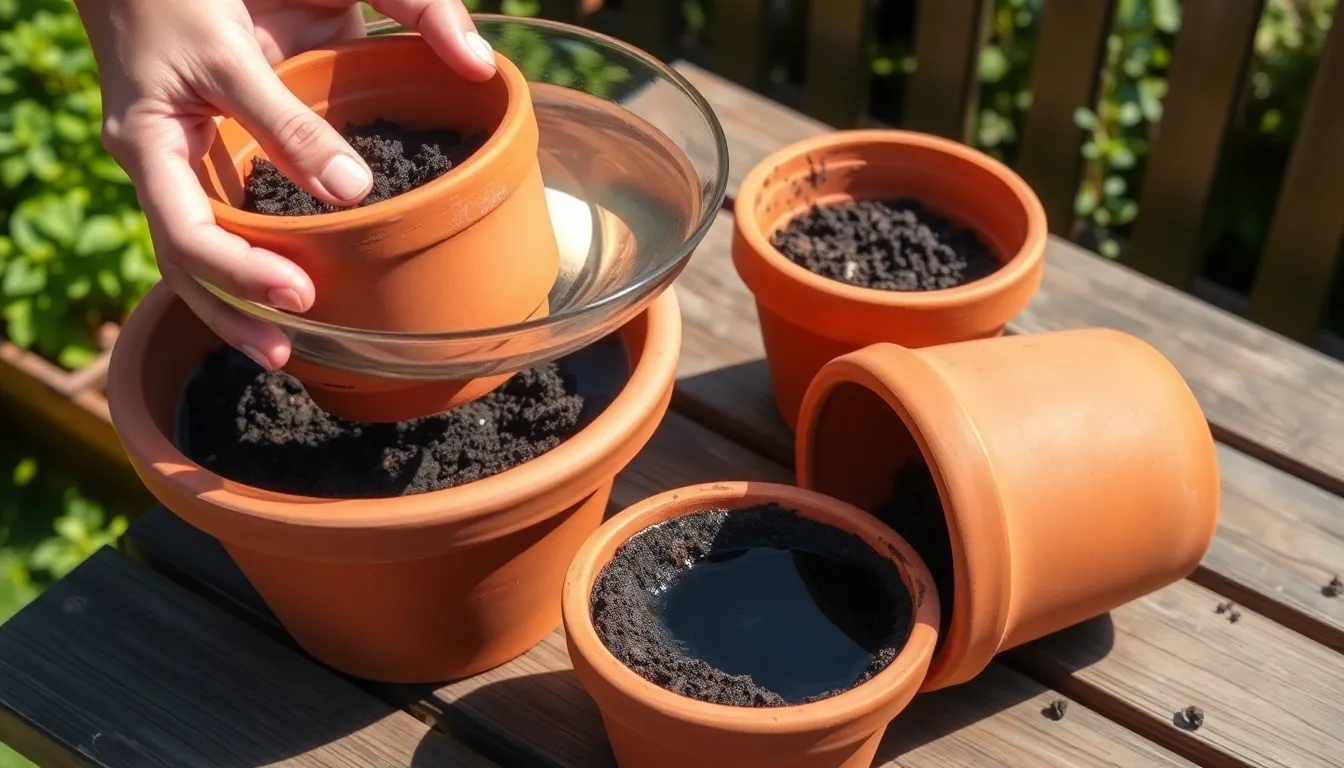
Proper preparation ensures your clay pots provide the ideal environment for healthy plant growth. We’ll walk through the essential steps to get your terracotta containers ready for their first planting.
Soak New Pots to Remove Manufacturing Residue
New clay pots contain dust, clay residue, and manufacturing salts that can harm plant roots. We recommend soaking new terracotta pots overnight in clean water to eliminate these harmful residues and condition the porous clay material.
Soaking reduces the pot’s natural tendency to wick moisture away from soil, helping maintain proper hydration levels for newly planted vegetation. This overnight process prevents dehydration stress and creates optimal growing conditions from day one.
Fresh terracotta absorbs water rapidly when dry, which can rob your plants of essential moisture during critical establishment periods. Conditioning the clay through soaking balances this absorption rate and protects your investment in healthy plants.
Season Pots Gradually to Prevent Cracking
Clay pots crack when exposed to rapid temperature changes or sudden moisture transitions. We season unused clay pots by gradually exposing them to moisture through periodic soaking or placement in naturally humid environments before first use.
Gradual moisture exposure allows the clay to absorb water slowly, reducing thermal shock and preventing costly container damage. This seasoning process strengthens the pot’s structure and extends its lifespan significantly.
Moving clay pots from completely dry conditions to wet planting environments creates stress fractures that compromise container integrity. Gentle conditioning prepares the material for regular watering cycles without structural failure.
Clean and Sterilize Previously Used Containers
Reused clay pots require thorough cleaning to remove old soil, mineral deposits, and potential pathogens that threaten new plantings. We scrub containers with wire bristle brushes or steel wool to eliminate all debris and buildup.
Disinfection involves soaking used pots in a solution of one part bleach to nine parts water for approximately 10 minutes. This sterilization process kills harmful bacteria, fungi, and other microorganisms that could damage healthy plants.
Following bleach treatment, we rinse thoroughly and soak containers in mild dish detergent solution before a final clear water rinse. Air drying completes the preparation process and ensures containers are ready for safe reuse.
Match Clay Pot Styles to Your Garden Aesthetic
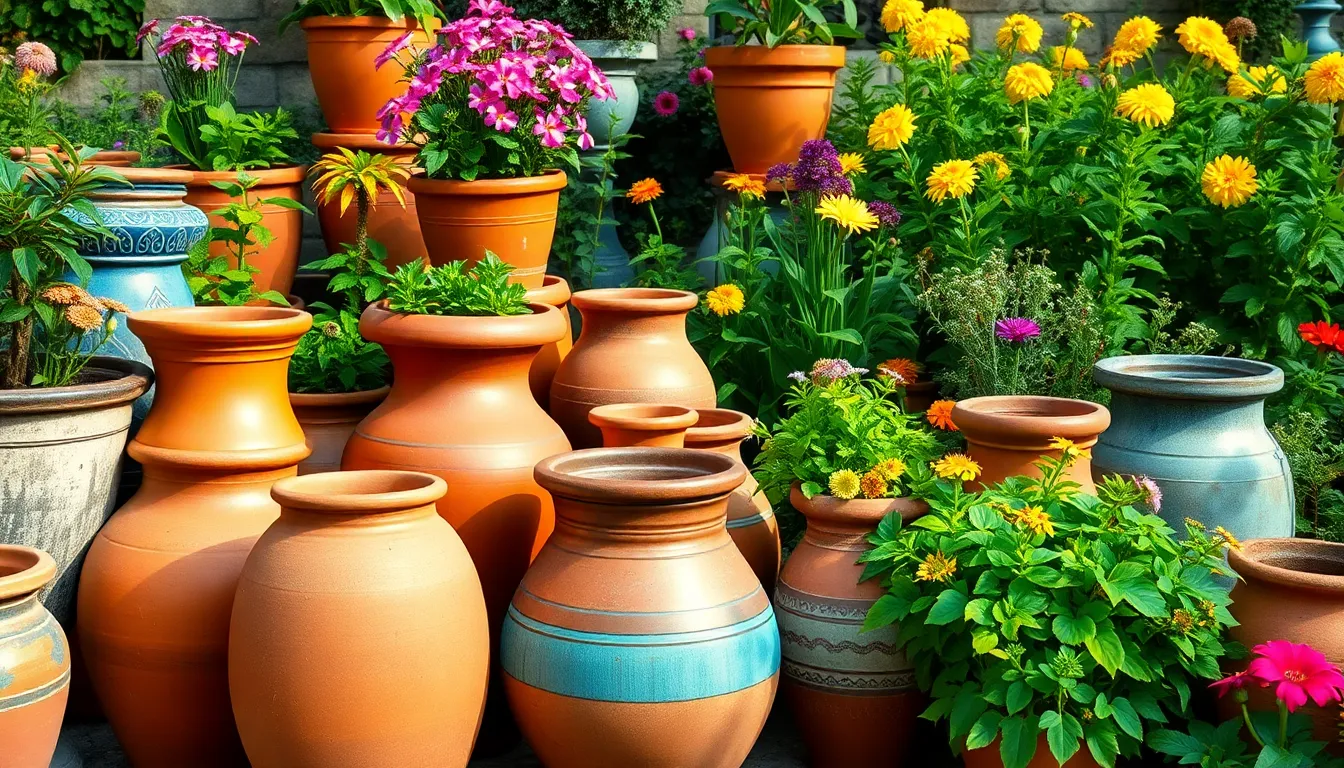
Selecting the right clay pot style helps create visual harmony between your containers and overall garden design. We’ve found that matching pot aesthetics to your industry theme enhances both functionality and curb appeal.
Classic Terracotta for Traditional Garden Themes
Classic terracotta pots deliver timeless elegance for traditional garden settings. Their natural reddish-brown hue complements rustic and Mediterranean landscapes perfectly, creating an authentic Old Industry charm that never goes out of style. We recommend using these unglazed containers throughout established herb gardens and cottage-style plantings where their earthy appearance blends seamlessly with weathered stone pathways and vintage garden accessories.
Terracotta’s breathable walls provide optimal growing conditions while maintaining traditional aesthetics. The porous structure allows air circulation and moisture regulation, making these containers ideal for lavender, rosemary, and other Mediterranean herbs that thrive in well-draining environments. We’ve noticed that their slight natural alkalinity subtly increases soil pH, which benefits plants preferring alkaline conditions.
Decorative Glazed Options for Modern Spaces
Decorative glazed clay pots offer vibrant colors and glossy finishes perfect for contemporary design statements. These containers feature sleek surfaces in bold hues like cobalt blue, emerald green, or crisp white that complement modern architecture and minimalist landscaping. We often select glazed options for urban balconies and geometric garden layouts where clean lines and striking colors create focal points.
Glazed surfaces retain moisture longer than unglazed terracotta while providing enhanced visual impact. The waterproof coating reduces water evaporation, making these containers excellent choices for moisture-loving plants like ferns and tropical species. We’ve found that while glazed pots may reduce breathability compared to terracotta, they offer longer-lasting color and require less frequent watering in sunny locations.
Rustic Aged Finishes for Cottage Garden Looks
Rustic aged finishes on clay pots enhance cottage garden aesthetics with weathered, lived-in charm. These containers feature distressed surfaces, moss-like patinas, or deliberately aged appearances that blend naturally with informal plantings and rambling flower borders. We particularly love using aged clay pots among climbing roses, wildflower meadows, and informal perennial beds where their vintage character adds authentic cottage appeal.
Weathered clay containers create instant maturity in new garden spaces. The aged patina mimics years of outdoor exposure, helping newly planted areas appear established and naturally evolved. We’ve discovered that these rustic finishes work exceptionally well with antique garden tools, weathered wood structures, and heirloom plant varieties that celebrate traditional gardening heritage.
Maintain Clay Pots for Plants Throughout the Seasons
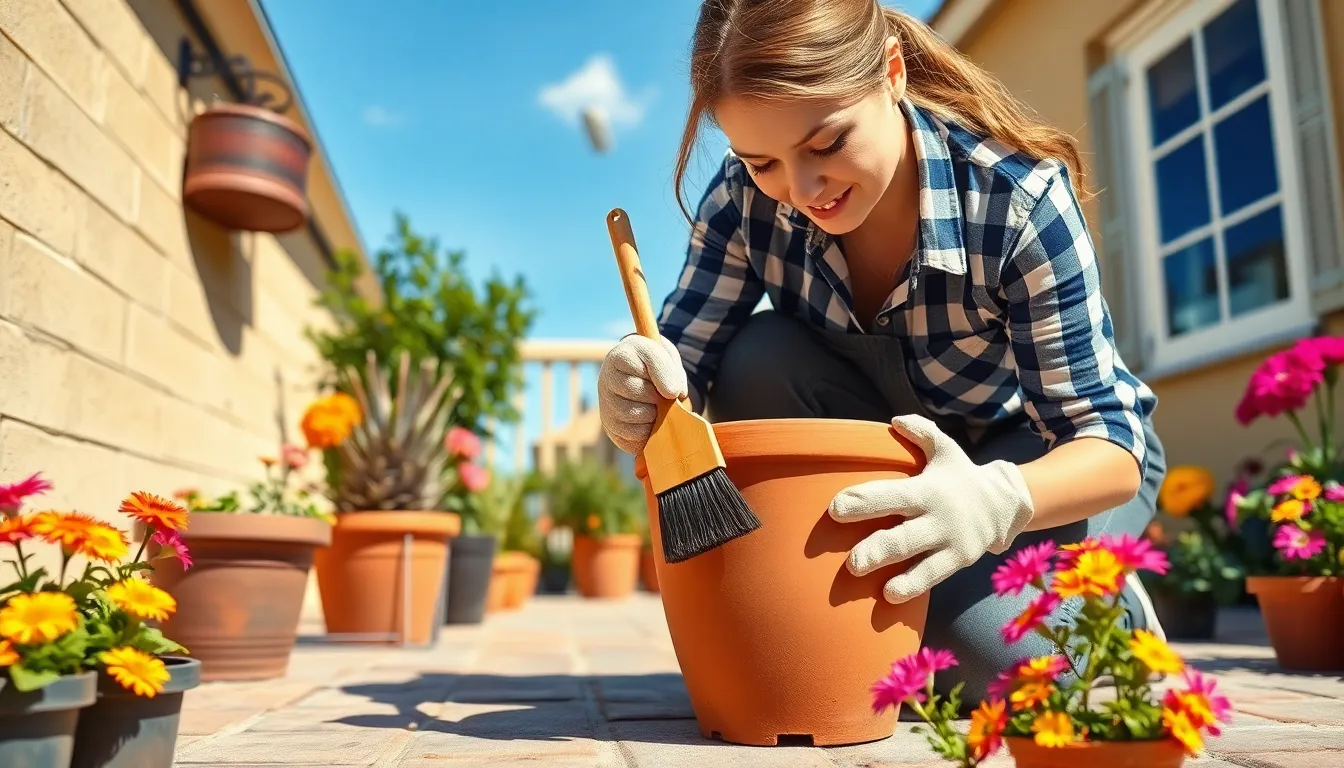
Seasonal maintenance ensures our clay pots remain functional and beautiful year-round. Regular care prevents damage and extends the lifespan of these valuable planting containers.
Clean Salt Buildup and Mineral Deposits Regularly
Remove old soil and debris from pots after each growing season to prevent disease and pest accumulation. We should empty containers completely and dispose of used potting mix to eliminate potential pathogens.
Scrub pots thoroughly with a stiff brush and clean water to remove dirt and white mineral deposits that accumulate on clay surfaces. These chalky residues indicate salt buildup from fertilizers and hard water.
Soak containers in cleaning solution using either one part white vinegar to four parts water or one part bleach to nine parts water for approximately 30 minutes. This process eliminates bacteria and dissolves stubborn mineral deposits that regular scrubbing can’t remove.
Rinse pots completely with fresh water after soaking to remove all cleaning solution residue. Air drying in direct sunlight provides natural sterilization and prevents moisture retention.
Protect Pots from Freeze-Thaw Damage in Winter
Drain excess water from all clay containers before winter temperatures arrive to minimize freeze-thaw expansion damage. Water trapped in porous clay expands when frozen and creates cracks that ruin pots.
Remove plants and soil from smaller movable containers to prevent internal moisture from freezing and splitting the clay walls. Empty pots survive winter conditions better than filled ones.
Cover exposed pots with plastic sheeting to block water contact during freezing periods. This barrier prevents snow and rain from saturating the clay and causing damage when temperatures drop.
Wrap larger immovable containers with insulation materials like hessian, fleece, or bubble wrap to protect plant roots and pot walls from freezing. These materials provide crucial thermal protection for permanent plantings.
Store Empty Pots Properly During Off-Season
Elevate containers off the ground using pot feet or wooden pallets to prevent moisture accumulation and frost damage during storage. Ground contact allows water to wick into clay and cause deterioration.
Stack pots carefully with padding materials like cloth or foam between each container to prevent chipping and cracking during storage. Metal pot feet can scratch clay surfaces without proper cushioning.
Keep containers covered or move them indoors in cold climates to prevent frost damage and moisture infiltration. Garages, sheds, or covered porches provide adequate protection from winter weather.
Choose dry storage locations away from areas prone to flooding or excessive humidity to maintain clay integrity throughout the dormant season. Proper storage prevents mold growth and structural weakening.
Troubleshoot Common Clay Pot Problems
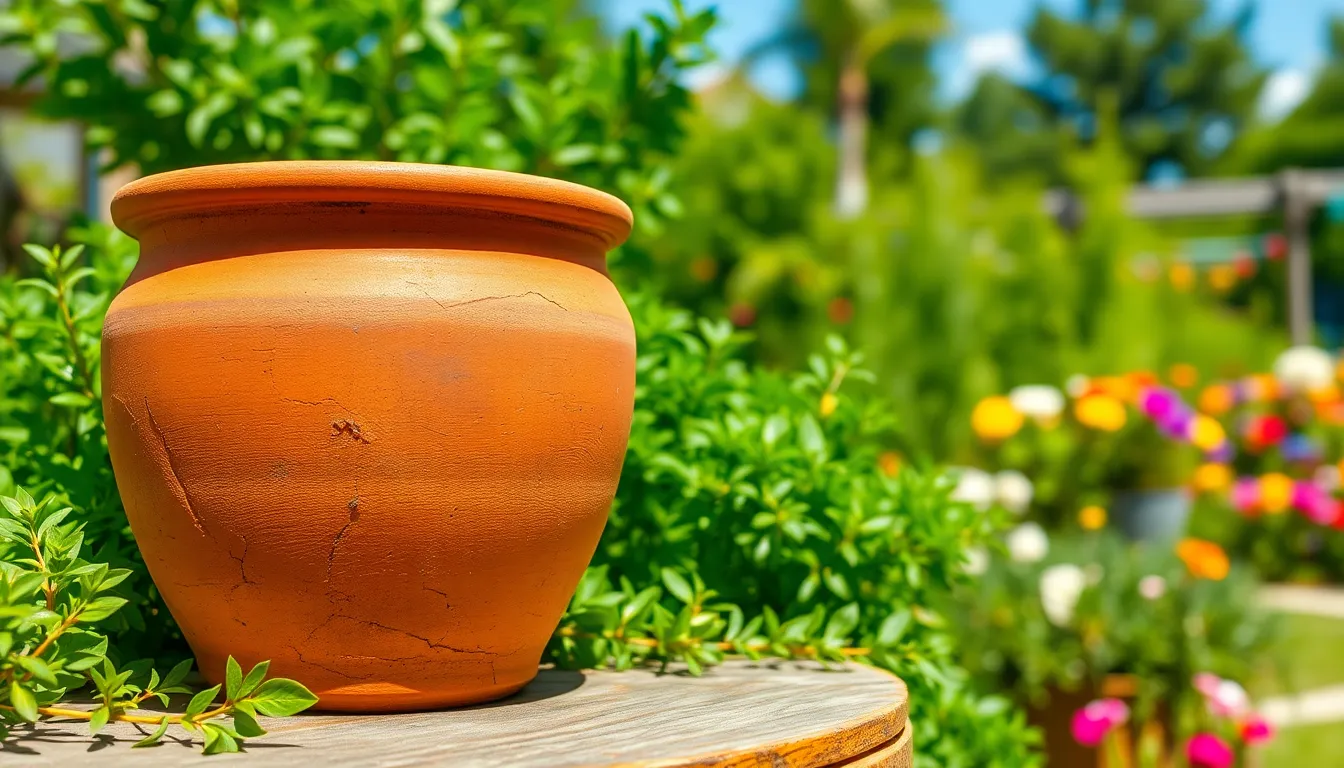
Even with proper selection and preparation, clay pots can develop issues that require our attention and quick answers.
Prevent and Repair Cracks in Clay Containers
Protect your terracotta pots from temperature extremes to avoid the most common cause of cracking. Clay pots crack easily when exposed to freezing temperatures or sudden temperature changes due to their porous and fragile nature.
Move containers indoors during cold weather if you live in areas where temperatures drop below freezing. We recommend storing clay pots in garages or sheds during winter months to prevent freeze damage.
Handle pots carefully during transport and repotting since physical impact from bumps or falls can cause immediate cracks. Lifting from the bottom rather than the rim provides better support for heavier containers.
Apply specialized terracotta adhesives for minor crack repairs, though prevention remains more effective than fixing damaged pots. Clean the crack thoroughly before applying any repair materials for better adhesion.
Avoid placing hot pots on cold surfaces or exposing them to rapid temperature fluctuations that cause expansion and contraction stress. Gradual temperature changes help clay materials adjust without structural damage.
Address White Residue and Efflorescence Issues
Identify the white residue as harmless mineral deposits called efflorescence that naturally occurs when moisture pulls minerals through porous clay walls. This chalky buildup doesn’t damage plants or containers but can affect appearance.
Clean mineral deposits with soap and water using a soft brush to gently scrub away accumulated residue. Regular cleaning prevents heavy buildup that becomes harder to remove over time.
Improve drainage to reduce mineral concentration in soil and water, which decreases the amount of minerals available for deposit formation. Using filtered or distilled water can minimize mineral content.
Accept patina development as natural aging since clay pots develop character over time through mineral deposits and weathering. Many gardeners appreciate this authentic aged appearance as decorative enhancement.
Rinse pots thoroughly after cleaning to remove soap residue that could interfere with the pot’s natural porosity and moisture regulation properties.
Handle Root-Bound Plants in Clay Pots
Monitor soil moisture more frequently since clay pots encourage faster soil drying, which can stress root-bound plants that struggle to access adequate water. Dense root systems restrict soil moisture retention significantly.
Check for roots growing through drainage holes as an early indicator that repotting time has arrived. Visible roots circling the soil surface also signal overcrowded conditions.
Repot into slightly larger clay containers when roots become densely packed, choosing pots only 1-2 inches wider than the current container. Oversized pots can create soggy conditions that harm plant health.
Prune overgrown root systems by trimming away circled or damaged roots before repotting to encourage healthy new growth. Sharp, clean tools prevent root damage during the pruning process.
Water more frequently but with smaller amounts to maintain consistent moisture for root-bound plants in porous clay containers. This approach prevents both drought stress and waterlogging conditions.
Compare Clay Pots to Other Container Materials
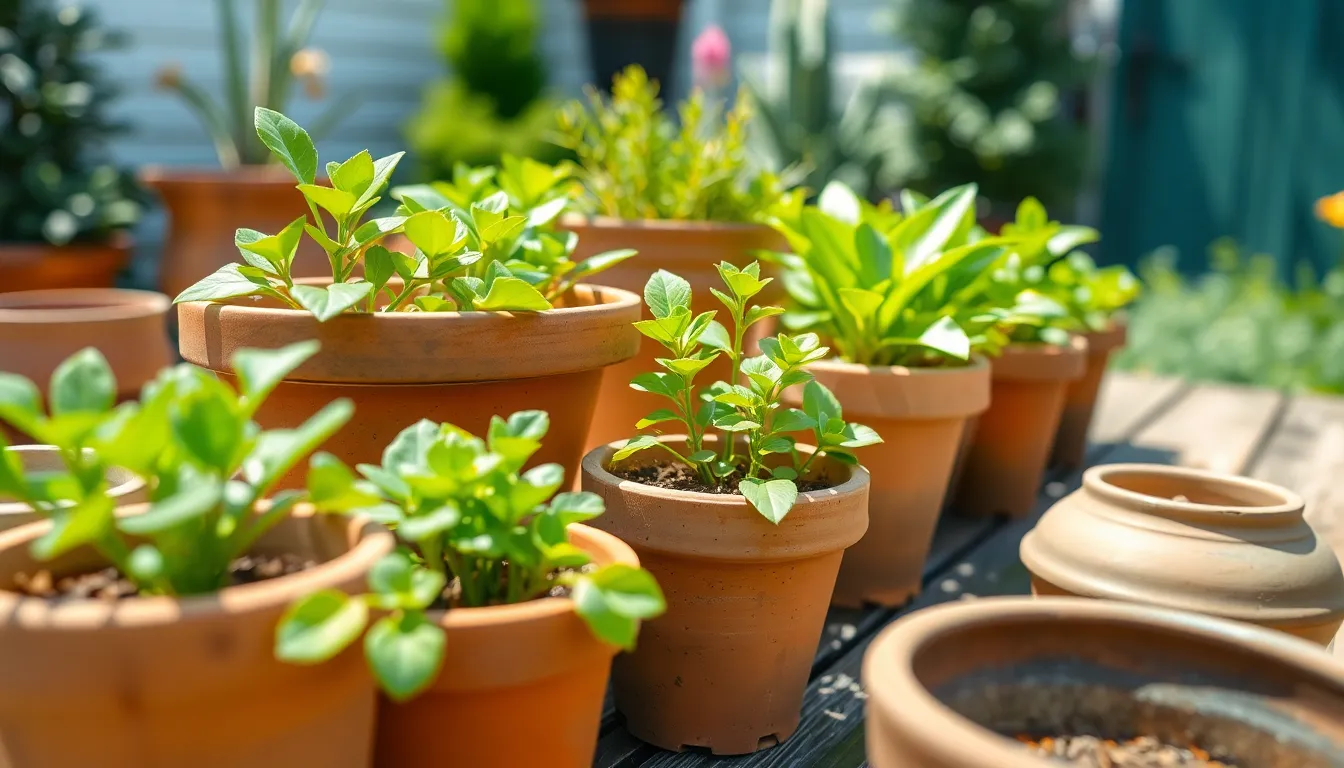
We’ve explored clay pot fundamentals, but understanding how they stack up against alternatives helps you make the smartest choice for your plants.
Clay vs. Plastic Planters for Plant Health
Clay pots promote superior root health through their porous structure. Air circulation reaches plant roots naturally, while moisture evaporates through container walls to prevent waterlogging and root rot. Plastic planters retain moisture for nearly twice as long as clay pots, creating potential overwatering risks for plants like cacti and succulents that require well-drained soil.
Plastic containers excel for moisture-loving plants and busy gardeners. These non-porous vessels maintain consistent soil hydration longer, making them ideal for plants that prefer steady moisture or gardeners who water less frequently. Clay’s faster evaporation rate means more frequent watering but dramatically reduces soil fungi and root disease risks.
Weight differences impact portability and stability significantly. Plastic planters stay lightweight for easy repositioning, while clay pots provide stable anchoring for tall or top-heavy plants. Plastic becomes brittle with prolonged sun exposure, whereas terracotta develops an attractive natural patina over time.
Terracotta vs. Ceramic for Durability
Terracotta offers maximum breathability but lower impact resistance. This unglazed fired clay material provides excellent airflow benefits through its naturally porous surface. Cracking occurs more frequently in terracotta, especially during freezing weather conditions that cause expansion and contraction.
Ceramic containers balance durability with reduced porosity. Glazed surfaces increase structural strength and decorative appeal while maintaining some airflow advantages. Glazing reduces drying speed compared to unglazed terracotta, creating a middle ground between clay and plastic moisture retention.
Durability varies significantly between glazed and unglazed options. Glazed ceramic pots resist weather damage better and last longer without breaking or chipping. Unglazed terracotta requires more careful handling but provides traditional charm and superior plant health benefits through enhanced breathability.
Cost-Effectiveness of Clay Pots Over Time
Initial investment costs favor both clay and plastic options. Clay pots start relatively inexpensive and offer excellent reusability for multiple growing seasons. Plastic planters typically cost less upfront and provide longer-lasting durability without replacement needs from accidental drops or weather damage.
Replacement frequency impacts long-term expenses differently. Clay’s fragility leads to occasional replacement costs when pots crack or break during handling. Plastic’s superior durability means fewer replacements over time, though UV degradation eventually requires container updates in sunny locations.
Plant health benefits offset replacement costs for serious gardeners. Better root development and reduced disease risks in clay pots often result in healthier, more productive plants. Plastic’s moisture retention can save on watering frequency but may contribute to overwatering problems that damage valuable plants, making clay’s health advantages cost-effective for long-term garden success.
Source Quality Clay Pots for Your Plant Collection
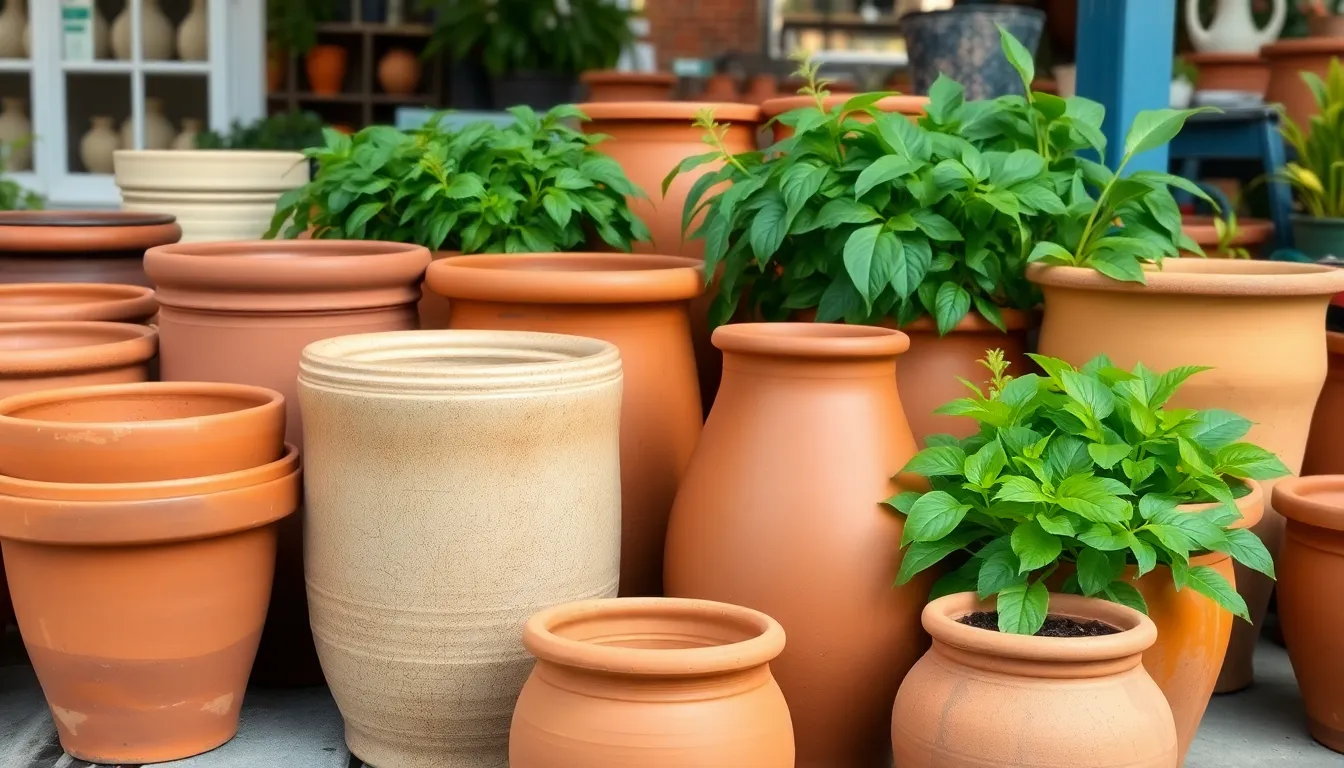
Finding the right clay pots can make all the difference in your plant collection’s success. We’ll guide you through the best sources to ensure you get containers that offer optimal drainage and durability.
Find Reputable Local Garden Centers and Nurseries
Local garden centers provide the advantage of seeing and feeling clay pots before purchasing them. These establishments typically stock high-quality terracotta and glazed options that meet professional growing standards. Staff members at nurseries offer valuable plant care advice and can recommend exact pot sizes for your particular plants.
Examine the pot’s construction by checking for uniform thickness and proper firing quality. Touch the surface to assess porosity levels, as well-made terracotta should feel slightly rough and breathable. Garden centers often carry pots with multiple drainage holes, which are essential for preventing root rot in moisture-sensitive plants.
Many local retailers source their clay pots from established manufacturers who specialize in horticultural containers. We’ve found that these venues often provide seasonal sales on bulk purchases, making them cost-effective for expanding plant collections. Regional nurseries may also stock locally-made pots that are specifically designed for your climate conditions.
Explore Online Retailers for Specialty Clay Pots
Online platforms offer access to artisanal and specialty clay pots not available in local stores. Browse through collections that feature unique glazing techniques and decorative finishes that can enhance your garden’s aesthetic appeal. Digital retailers often provide detailed product specifications, including pot dimensions and drainage hole configurations.
Compare shipping policies when ordering heavy clay containers, as some retailers offer free delivery for orders above certain thresholds. Read customer reviews to verify the quality of terracotta porosity and durability before making purchases. Online marketplaces frequently showcase international pottery styles that bring distinctive character to plant displays.
Specialty plant retailers on digital platforms often curate collections specifically for different plant types. We recommend checking for retailers who specialize in succulent containers or tropical plant pots, as they understand the exact drainage requirements for these species. Premium online suppliers may offer pre-seasoned clay pots that are ready for immediate planting.
Consider Handmade vs. Mass-Produced Options
Handmade clay pots offer unique aesthetics and often superior craftsmanship compared to factory-produced alternatives. Artisan potters typically use traditional firing methods that create more consistent porosity throughout the pot walls. These containers may feature subtle variations in color and texture that add character to your plant collection.
Evaluate the price difference between handcrafted and mass-produced options based on your budget and aesthetic preferences. Mass-produced clay pots provide affordability and uniform sizing, making them practical for large-scale gardening projects. Factory-made containers often come with standardized drainage holes and consistent wall thickness.
Inspect handmade pots for structural integrity, as some artisan pieces may have thicker bases or reinforced rims that enhance durability. Consider the firing temperature used in production, as higher-fired clay pots resist cracking better in temperature fluctuations. We’ve observed that handmade terracotta often develops attractive patina over time, while mass-produced versions may show more uniform aging patterns.
Conclusion
We’ve explored every aspect of clay pots to help you make informed decisions for your plant collection. From selecting the right size and material to proper preparation and maintenance these containers offer unmatched benefits for plant health.
Whether you choose breathable terracotta for succulents or glazed clay for moisture-loving plants you’re investing in your garden’s long-term success. The superior drainage root health and temperature regulation that clay pots provide make them worth every penny.
With proper care and seasonal maintenance your clay pots will serve your plants beautifully for years to come. Start building your collection today and watch your indoor garden flourish like never before.
Frequently Asked Questions
Why are clay pots better than plastic containers for houseplants?
Clay pots offer superior breathability and drainage compared to plastic containers. Their natural porosity allows air to reach plant roots and prevents waterlogging, which commonly causes root rot in plastic pots. Clay pots also provide better moisture regulation, creating an ideal environment for healthy root development and reducing the risk of overwatering.
How do I choose the right size clay pot for my plant?
Select a clay pot that’s 1-2 inches wider in diameter than your plant’s current root ball. This allows for modest growth without creating overly soggy conditions. Choose deeper pots for deep-rooted plants like tomatoes, and shallow, wide containers for shallow-rooted species. Avoid oversized pots, especially for succulents and cacti.
What’s the difference between terracotta and glazed clay pots?
Terracotta pots are unglazed and highly breathable, making them ideal for moisture-sensitive plants like succulents. They provide excellent drainage and temperature regulation. Glazed clay pots retain more moisture and are better suited for plants requiring consistent hydration. They also offer decorative appeal with various colors and finishes.
How should I prepare new clay pots before planting?
Soak new terracotta pots overnight to remove manufacturing residues and condition the porous material. This prevents the pot from absorbing too much moisture from your plant initially. Clean and sterilize previously used pots to eliminate old soil and pathogens. Allow pots to dry completely before planting.
How can I ensure proper drainage in clay pots?
Check that your clay pot has adequate drainage holes – larger containers may need multiple holes. Add a drainage layer using materials like stones or LECA at the bottom. Position saucers correctly to avoid standing water, and consider elevating pots slightly to improve water flow and prevent waterlogging.
What maintenance do clay pots need throughout the seasons?
Regularly clean salt buildup and mineral deposits from pot surfaces. Remove old soil and debris after each growing season. In winter, protect pots from freeze-thaw damage by draining excess water and covering them. Store pots in dry, elevated locations during the off-season to maintain their integrity.
How do clay pots compare to other container materials in terms of cost?
While initial costs may be similar to plastic or ceramic containers, clay pots offer better long-term value. Their superior drainage and root health benefits can prevent plant loss and reduce replacement costs. Though terracotta may be less impact-resistant than ceramic, the health benefits often outweigh potential replacement expenses.
Where can I find quality clay pots for my plant collection?
Local garden centers and nurseries offer high-quality terracotta and glazed options where you can examine construction and drainage features firsthand. Online retailers provide access to unique and artisanal pots – compare shipping policies and read customer reviews. Consider both handmade pots for uniqueness and mass-produced options for affordability.

